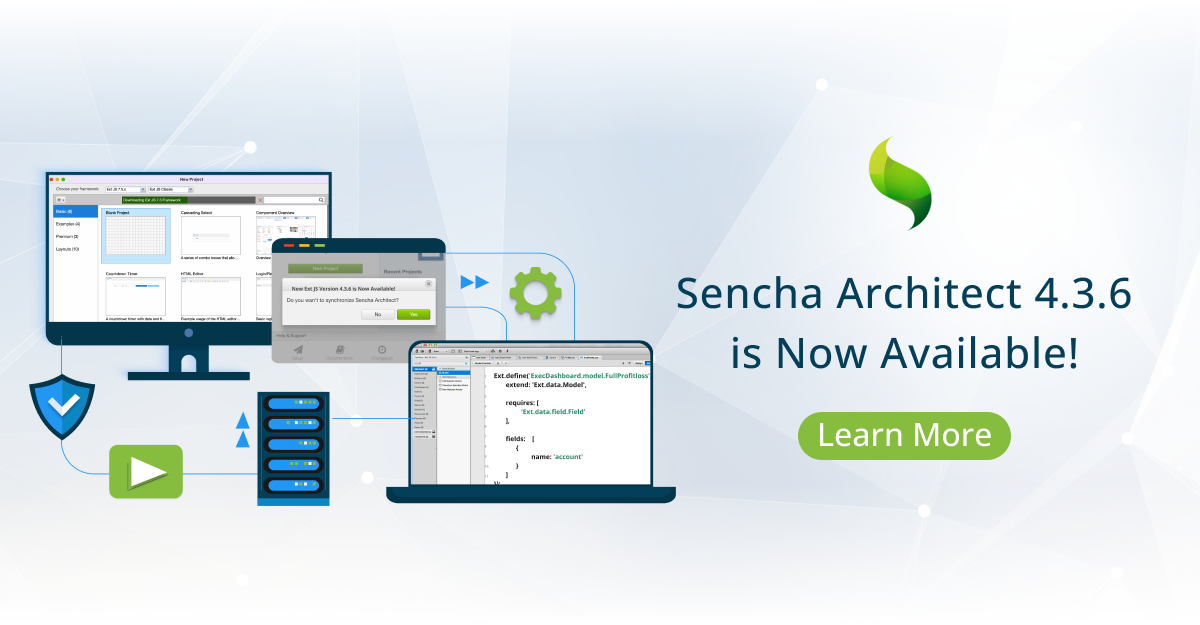Introducing Sencha.io–The First Mobile HTML5 Cloud
 Today we’re very excited to announce the beta availability of Sencha.io, the first cloud built for the mobile web developer. Sencha.io makes it easy for you to build applications that deliver shared experiences.
Today we’re very excited to announce the beta availability of Sencha.io, the first cloud built for the mobile web developer. Sencha.io makes it easy for you to build applications that deliver shared experiences.
The Sencha.io platform provides a set of cloud services that make it easier for mobile web app developers to deliver robust web functionality to users. Your mobile apps goes well beyond just the client itself and your apps need to be able to create, store, and share data and messages with the app’s users.
Imagine you need to build an expense reporting application for your company using Sencha Touch. Typically you’d need a place to store your data, a way to route approvals, a way to have your users log in. You’d pick databases and build business logic, and write thousands of lines of server code along the way. With Sencha.io, with only a few lines of JavaScript code–running just in the browser–you can power this entire experience.
Sencha.io is an entirely new way for the client developer to think about the cloud. To store data, you simply tell your model to store data. And it does the rest. If you need to send messages to other users, you enable messaging with just one line of code. If you need to listen for messages, just set up a callback. And Sencha.io does the rest. If you need to log users in from Facebook, you just request the login with an API, and Sencha.io automates the whole process. And if you need a place to deploy your application, Sencha.io provides that, too.
Today we’re launching the beta with four services: Data, Messages, Login, and Deployment.
h3. Sencha.io Data
 Data is the heart of many applications–you users need to store data and share it on all their devices. They also want to share that data with their friends. Sencha.io Data makes it easy to for apps to store data in the cloud and access it any time. It’s a synchronized store that lets you write data to any device, seamlessly merge conflicts, and keep working when the network isn’t available–a necessity with mobile considering the unreliability of the network. As a Sencha Touch developer, all you need to do to get started using Data is change the proxy in your app, and automatically your data store synchs with the cloud.
Data is the heart of many applications–you users need to store data and share it on all their devices. They also want to share that data with their friends. Sencha.io Data makes it easy to for apps to store data in the cloud and access it any time. It’s a synchronized store that lets you write data to any device, seamlessly merge conflicts, and keep working when the network isn’t available–a necessity with mobile considering the unreliability of the network. As a Sencha Touch developer, all you need to do to get started using Data is change the proxy in your app, and automatically your data store synchs with the cloud.
h3. Sencha.io Messages
 Structured data is the right solution for storing and sharing “row” based data, but there are so many times when rows and columns aren’t the right solution. Messages lets an app send one-to-one and one-to-many messages to tell other users that something has changed. Messages lets you send small JSON objects to users and to devices, stores them, and makes them available on callbacks for pickup. If you want to listen for messages, just register a callback in your app and it starts picking them up.
Structured data is the right solution for storing and sharing “row” based data, but there are so many times when rows and columns aren’t the right solution. Messages lets an app send one-to-one and one-to-many messages to tell other users that something has changed. Messages lets you send small JSON objects to users and to devices, stores them, and makes them available on callbacks for pickup. If you want to listen for messages, just register a callback in your app and it starts picking them up.
h3. Sencha.io Login
 All apps need user data, and Login makes it easy for an app to provide registration and login functionality, enable users to have accounts, and soon, to bring in users from Facebook and Twitter. Using Sencha.io Login, your application can be set to require a login when a user visits your URL or after the user has already downloaded or started using your app. It’s up to you. Then store the user data in the cloud so it’s available on any device the user logs in to.
All apps need user data, and Login makes it easy for an app to provide registration and login functionality, enable users to have accounts, and soon, to bring in users from Facebook and Twitter. Using Sencha.io Login, your application can be set to require a login when a user visits your URL or after the user has already downloaded or started using your app. It’s up to you. Then store the user data in the cloud so it’s available on any device the user logs in to.
h3. Sencha.io Deployment
 The deployment service makes it easy for you to deploy your client application, and gives you a place to manage your app and the services it’s using. Sencha.io’s domain for app deployment is “senchafy.com”. Sencha.io also provides a developer console you use to upload apps, perform version management, and push apps to the production environment or a development environment (“senchafy-dev.com”). You can also manage your team, manage your user groups, and see the Sencha.io system status.
The deployment service makes it easy for you to deploy your client application, and gives you a place to manage your app and the services it’s using. Sencha.io’s domain for app deployment is “senchafy.com”. Sencha.io also provides a developer console you use to upload apps, perform version management, and push apps to the production environment or a development environment (“senchafy-dev.com”). You can also manage your team, manage your user groups, and see the Sencha.io system status.
h3. Getting Started
Full documentation, including API documentation for how to integrate the Sencha.io SDK into your application, and guides on all the services are available at the “Sencha Documentation Center”:http://docs.sencha.com/io/1-0/.
Of course, we’ll be adding features and adding polish as we go through the beta. We’ve set up a forum for you to share your feedback and your questions with us, and we’ll be communicating our plans there and on the Sencha blog. We’re excited to have you try Sencha.io and to see what kind of apps you’ll build with it.
So head on over to “http://developer.sencha.io”:http://developer.sencha.io, create a team, and download the SDK. If you have a Sencha ID (from our Forums, or Designer or Animator) you’re already registered. Login, and get started!
P.S. if you had been using Sync before, your application will continue to work. Sync has become a part of Data. If you’ve been using Src before, again, your application will continue to work as it’s become a part of the Deployment service. They both continue to work as-is.

We’re excited to announce the official release of Rapid Ext JS 1.0, a revolutionary low-code…

The Sencha team is pleased to announce the availability of Sencha Architect version 4.3.6. Building…

Sencha, a leader in JavaScript developer tools for building cross-platform and enterprise web applications, is…












